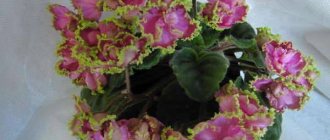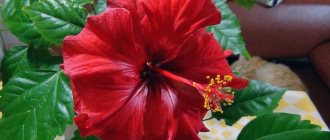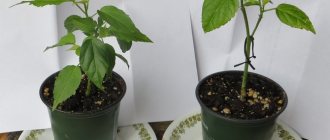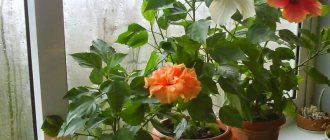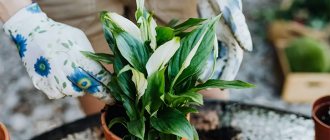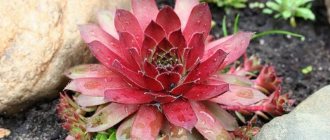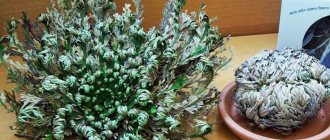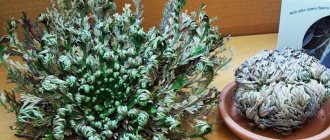Photo: greeninhouse.ru For the extraordinary beauty and characteristic shape of the buds, the delicate hibiscus was nicknamed the “Chinese rose.” The flower is surrounded by so many legends and mystical mysteries that some are still superstitiously afraid to keep it at home. However, there are no objective reasons to refuse the desired flowerpot. We’ll tell you in this article how to grow a Chinese rose healthy and spectacular!
What kind of plant
Hibiscus is a genus of flowering plants in the large Malvaceae family. Hibiscus are very diverse and are represented by hundreds of species. They are perennial and annual, tree-like, deciduous and herbaceous, and can grow as a large bush or as a separate flower.
Features of hibiscus:
- The plant can overwinter under shelters and withstand frosts down to minus 30°C.
- Depending on their formation, plants can transform into tree-like and standard forms.
- The height of plants is determined by pruning - the same species can reach a height of half a meter and a couple of meters.
In nature, you can find species of hibiscus that grow up to 20 m in height.
Botanical characteristics of hibiscus
The morphological, physiological and environmental parameters of this plant are represented by the following characteristics:
- Ecological group – perennial (rarely annual, for the herbaceous form) evergreen shrub, a woody form of life is also found;
- Department: Flowering plants;
- Class: Dicotyledons;
- Family: Malvaceae;
- Genus: Hibiscus (Hibiscus);
- Leaves: petiolate, more or less incised with reticulate venation, leaf blade simple;
- Flowers simple or double;
- Fruit: five-leaf capsule with smooth or slightly hairy seeds. Seeds are contained in large quantities.
Description of appearance
Most of all, our flower lovers know the indoor hibiscus, which they call the Chinese rose. Many considered it boring and unattractive, and it was grown mainly in tubs. In almost every school or clinic one could find a large bush with single red flowers.
In fact, hibiscus is much more diverse. This plant is actively conquering gardens and indoors today. New varieties of hibiscus are diverse - they have different leaves, flowers, and other botanical features. But there are a number of external characteristics common to all hibiscus.
Appearance Features:
- Leaves. Glossy, they look, although rustic, but fresh and elegant. They are oval or ovoid in shape. Their ends are pointed and their edges are jagged. The color is rich, cold green.
- Flowers. They are shaped like small gramophones. They may differ in size and “design”. There are varieties in which the flowers are decorated with fringe along the edge of the petals. The colors of the flowers are very different - there are yellow, red, pink, orange, and purple shades. The diameter of the funnel-shaped flowers is up to 10 cm, but larger specimens may also be found. In the center there is a dark spot - a pistil, in which fused long stamens are concentrated. The length of the latter can reach 10 cm.
- Roots. Powerful, branched, well developed.
general information
Chinese is one of the most beautiful ornamental plants with large flowers, from which they even weave wreaths for newlyweds in India. The mysterious flower is so popular that in many regions it appears among the national symbols: from Malaysia to the Hawaiian Islands. It came to us from Asia and the Pacific Islands. The leaves of the Chinese rose resemble those of birch - the same dark, smooth and slightly jagged. But it is the flowers that are noteworthy - large narrow bowls, widely opening with petals up to 25 cm in diameter. The most common varieties are red, but there are pink, white, yellow and multi-colored varieties.
Photo: cultland.ru
Where does it grow
Hibiscus is a heat-loving plant and is widespread in countries with tropical and subtropical climates. Some species are also found in temperate latitudes. Representatives of this genus can be found in a variety of countries and continents.
Hibiscus grows mainly in Africa, North and South America, and Europe. In Russia they can be seen in the Caucasus, Crimea and the Far East. But Europeans first encountered this plant in the Hawaiian Islands, from where they brought it first to Europe and then to America.
Chinese rose – photo
Breeders waste no time, and varieties of Chinese roses are very diverse. But all of them are undeniably beautiful and impressive - this is clearly visible in our photo selection!
Photo: 2sotki.ru
Photo: sveklon.ru Photo: jardineriaon.com
Photo: supersadovod.ru
Photo: vosadu-li-vogorode.ru Photo: oir.mobi
Photo: fotokto.ru Photo: pinterest.ru Photo: 2sotki.ru
Photo: fotoload.ru
Photo: oir.mobi
Photo: tchudesa.ru
Photo: oir.mobi Photo: landshaftnik.com
Photo: oz90.ru
Photo: pixabay.com
Photo: oprimetax.ru
Photo: ru.wallpaper.mob.org
Photo: ru.wallpaper.mob.org
Photo: tvsamara.ru
Photo: eldomo.ru
Photo: 2sotki.ru
Photo: unipack-ug.ru
Photo: oir.mobi
Photo: supersadovod.ru
Photo: dachnyedela.ru
Photo: pinterest.com.au
Photo: greencity-spb.rf
Photo: flo.discus-club.ru
Photo: kartoska.ru
Did you like the post? Subscribe to our channel in Yandex.Zen, it really helps us in our development!
Features of flowering
The main advantage of hibiscus, which gardeners and landscape designers appreciate, is its abundant and beautiful flowering. The flowering of each bud lasts only a couple of days, but in general the flowering can be long - its duration depends on the species and growing conditions.
Flowering Features:
- Hibiscus flowers can be either fragrant or completely devoid of any aroma. Moreover, the latter option is more common.
- The buds usually open in the morning when the sun rises. In the evening, the buds close and fade, and flowering ends. The next morning new flowers will bloom.
- With proper care, from 20 to 50 buds can bloom on each branch at the same time.
- Flowering begins in spring or early summer, and can last until autumn. Indoor hibiscus can bloom from February to October.
The dormant period begins in November and lasts until February. At this time, the room temperature is reduced to +14…+16°C. The flower, even at rest, must receive enough light and water.
Since hibiscus comes from the tropics, it can bloom all year round. True, this is only possible if appropriate conditions are created for it throughout the year.
How to properly prune hibiscus at home
The Chinese rose, or Chinese hibiscus, is considered one of the most beautiful ornamental plants. However, to achieve the ideal shape for the tree to have an attractive appearance, it must be pruned. There are several types of pruning. Her choice depends on the goal pursued by the owner. This could be removing damaged areas or shaping the appearance.
Types of pruning:
- Selective. This type of pruning is designed to maintain the required shape and size. It is better to combine the time for it with the beginning of the growing season in order to get good flowering.
- Topping. This procedure helps stimulate the growth and development of new branches. In addition, its main distinguishing feature is that the main part of the branches remains intact, only a small section is removed. This method is usually used for young hibiscus specimens.
- Corrective trimming. The use of this method is recommended if the branches are quite large. In this case, the cut should be made in a place where there is wood that is still alive. If the cut is white and has a hard structure, then the branch will no longer grow as it is dead.
- Strong. This method is used if the plant is already in critical condition and cannot be saved by either care or treatment.
In order to properly prune a plant and not harm it, you must follow a number of rules:
- First of all, you should set a goal and choose a method;
- then you need to thoroughly wash the instruments. They should also be as sharp as possible, otherwise the cuts will be uneven, which will worsen the appearance and harm the plant: the branches will take a very long time to heal. In addition, you can disinfect instruments using alcohol;
- It is better to choose spring or summer for the pruning procedure;
- after cutting off unnecessary parts of the Chinese rose (hibiscus), its care remains the same;
- It is better to make the cut at an angle of forty-five degrees, and treat the wound areas with crushed, charcoal or activated carbon;
- the apical part is cut off so that there is still space above the outermost branches on top;
- It is very important not to cut off more than two-thirds of the branch.
By following all the above rules, you can minimize the damage caused to the plant during pruning.
Planting garden hibiscus
In the garden, hibiscus can be grown both in the ground and in large flowerpots. For planting, seedlings are used - purchased or grown with your own hands.
Garden hibiscus
Disembarkation dates
Hibiscus is planted in open ground/vases twice a year:
- In the spring. It is recommended to plant in May, when the soil has warmed up to +15°C and the threat of return frosts has been eliminated.
- In autumn. Planting at this time of year is undesirable, especially in temperate latitudes. Seedlings rarely have time to take root and grow stronger before frost. If, after all, planting is done in the fall, then the tree trunk circles are carefully mulched, and the seedling itself is wrapped in dense material or covered with spruce branches.
Site selection
In order for a plant to grow and develop quickly, you need to choose the right place for it. The requirements of hibiscus for light, moisture, soil, and the movement of air masses are taken into account.
How to choose a suitable place for planting hibiscus in the garden:
- Lack of bright sun;
- Protection from drafts and strong winds;
- The site should be well drained;
- The soils are loose and nutritious, with a neutral or slightly alkaline reaction.
If the plant is grown by seeds, then sowing begins in mid-winter. Ready seedlings are planted in open ground after stable heat has been established.
Hibiscus domestic
Selection of seedlings
The easiest and fastest way to decorate your dacha with hibiscus is to buy seedlings and plant them in beautiful tubs or in open ground.
How to choose hibiscus seedlings:
- The flower must look healthy;
- It should be visible what color the flowers will be;
- The roots are healthy, without damage.
To check the roots of the plants, just tap the container a little and pull the stem up. After this, you can inspect the root system.
What causes hibiscus
Rosan is quite unpretentious in care, so even if some mistakes were made during cultivation, most likely this will not cause much harm to the plant. But if problems nevertheless arise, it is necessary to analyze how the hibiscus (Chinese rose) has been cared for recently; perhaps systematic violations will be discovered, which were the cause. Among such violations are:
- growing hibiscus indoors with very high temperatures and insufficient air humidity;
- timely regular spraying was not carried out, this procedure is especially important in the summer;
- the plant was exposed to direct sunlight or stood in a draft or wind for a long time;
- the plant was not cleaned of particles of dust and dirt;
- excessive watering, which could cause root rotting;
- Poor quality water was used for irrigation; damage can be caused by poorly settled water or with a large amount of harmful impurities;
- the impact of pests on the plant, which could also appear due to interaction with an infected hibiscus specimen;
- timely replanting and fertilization were not carried out;
- excess nutrients in the soil due to numerous fertilizing;
- insufficient amount of light.
If all the conditions necessary for good growth are met, then hibiscus will delight you with its long flowering and long life.
Planting seedlings
The seedlings do not need any additional procedures; you can safely transplant them into a plot or into a pot of suitable size.
How to plant hibiscus:
- Prepare the soil. Dig up the area in advance, adding peat and sand for digging. You can also add organic matter - humus and compost. For the tub, prepare the mixture. For example, this composition:
- garden soil - 2 parts;
- peat - 4 parts;
- sand - 1 part.
- Dig a hole for planting. Its volume should be such that the seedling fits comfortably in it (about twice the size of the roots). The intervals between adjacent pits are 1.5-2 m.
- Prepare the hole for planting. Place a 10-15 cm layer of drainage on the bottom. This can be pebbles or small crushed stone. Pour sand onto the drainage, then compost.
- Plant a seedling. Carefully remove the seedling from the planting pot. Place the plants in the center of the hole, strictly vertically, and carefully sprinkle its roots with the soil mixture prepared in advance. Make it from a mixture of sand, peat and the top layer of earth removed when digging a hole.
- Complete landing. Form a circle near the trunk - a recess in which water will accumulate during watering.
- Watering. Pour 10 liters of water into the furrow around the seedling.
- Trimming. Immediately after planting, all shoots are shortened by half their length.
Additionally, watch the video instructions on planting hibiscus in the garden:
The root collar of a hibiscus seedling should be slightly below ground level.
If you are going to plant hibiscus in the garden, you usually use purchased planting material for this purpose. Plants can serve as a wonderful decoration for a summer cottage. If winters are harsh, the plants are transplanted into tubs and moved to the basement. Or they carefully insulate the plant.
Garden landscaping ideas using hibiscus
Hibiscus bush is often used by landscape designers to create beautiful landscapes. This is explained by its colorful and abundant flowering, a large palette of shades, and the absence of numerous root shoots.
The Chinese garden rose has a lot of planting options in landscape design. It is used:
- as a bouquet planting . From 3 to 5 bushes of different shades are used. The composition can also be made monochrome. When the trees grow, their crowns will close together and form a large tent. And inside the planting it will be possible to arrange a place to relax. In this case, tall varieties of hibiscus from 2 to 3 m are chosen;
- when planting two or more plants side by side . Then their trunks will need to be braided at a young age, while they are flexible. As they grow, they will create an amazing multi-colored cloud. Not everyone will immediately understand that there are several plants in front of them, and not just one rose blooming with multi-colored buds;
- in single plantings against a background of green lawn . A lonely hibiscus in landscape design looks elegant and impressive;
- in mixborders . Low-growing varieties are used;
- in plantings with roses . These two cultures look elegant and harmonious together. It is better to choose low-growing roses;
- as a screen . In this case, hibiscus is planted against the background of walls, fences and in recreation areas. It goes well with white wrought iron garden furniture;
- from the street against the backdrop of the yard . Emphasizes the impeccable taste and status of its owners;
- with conifers . This planting is suitable for decorating the front area.
Tip: Swamp hibiscus will be a great addition to an artificial pond in your yard.
In conclusion, it is worth noting that the hibiscus garden shrub is suitable for any landscape design. It will not only transform it, but also emphasize a special style. This plant is extremely beautiful, long-flowering, and not too difficult to care for.
Planting indoor hibiscus
If the hibiscus is to grow at home, decorating the interior with its appearance, it is necessary to prepare planting containers for it in advance. A seedling for planting can be grown from seeds, but it is easier to buy ready-made seedlings.
Soil preparation
Its development and growth depend on the quality of the soil mixture on which the young hibiscus will grow. The soil in the pot should be fertile, loose, with a neutral reaction.
The optimal composition of the soil mixture for home growing hibiscus:
- leaf soil - 2 parts;
- turf soil - 2 parts;
- humus - 2 parts;
- sand - 1 part;
- wood ash - 0.5 parts.
Another option for soil mixture:
- peat - 2 parts;
- humus - 1 part;
- garden soil - 1 part;
- washed sand - 0.5 parts.
Indoor kibiscus
Peat has high acidity, so for every liter of soil mixture add a quarter cup of wood ash and 1 tbsp. l. complex mineral fertilizer.
Seedling preparation
Once purchased planting material is brought home, it is carefully inspected.
How to check the health of a hibiscus seedling:
- The stems and leaves should not show signs of damage, disease or pests.
- Remove the plant from the planting container as carefully as possible and inspect the roots. There should be no traces of root worms or rot on them. Typically, hibiscus is sold in plastic pots, from which seedlings can be easily removed.
If damage is found on young hibiscus, it is necessary to immediately treat them with appropriate agents against diseases (fungicides) and pests (insecticides).
Possible warning signs:
- Spots and dots;
- Uneven yellowness on leaves;
- Web.
What humidity is needed for hibiscus?
This type of plant is demanding on drainage and a constant supply of organic matter. However, ensuring these conditions, although mandatory, does not cause much trouble to the owner. For Chinese hibiscus, care is very important. It is enough just to pay attention to maintaining the required level of soil moisture and preventing the roots from rotting. To do this you need:
- add a little clay to the substrate, it will help the hibiscus achieve higher growth rates;
- to avoid diaper rash, mulch the soil;
- prevent water from stagnating when watering the flower frequently;
- use drip irrigation; however, it is important not to injure the delicate petals, so moisture should not get on them;
- Carry out regular spraying to avoid drying out and maintain the desired level of humidity.
If these conditions are met, the Chinese rose will receive the most comfortable atmosphere for good growth. This is especially important at home, where heating systems are constantly running.
When is transplantation and transshipment necessary?
Many people argue about replanting hibiscus - when it is necessary to move the seedling to a new location. The fact is that hibiscus is usually brought from Holland. They grow in pots with excellent soil mixture, which gives them a wonderful appearance.
If suddenly transplanted into a new soil mixture that is less perfect, the plant may react poorly, even to the point of death. Therefore, you need to carefully prepare for transplantation by making the most nutritious mixture possible.
If you still decide to transplant the seedling into a new pot/flowerpot immediately after purchase, then only the transshipment method is used. This method is preferred when transplanting any flowers.
Transplantation is carried out when:
- Plant diseases;
- The appearance of insects in the soil;
- Root rot;
- Incorrect composition of soil mixture.
Plant replanting is carried out with a complete replacement of the soil, and transshipment is carried out along with a lump of earth. In the first case, there is a high risk of damage to the roots, in the second it is minimized.
Why doesn't hibiscus bloom?
Many gardeners sooner or later have a question about why hibiscus (Chinese rose) does not bloom. In this situation, it is obvious that the flowering of a plant is a reward for caring owners. And if the flower still does not appear, it means that there are deficiencies in care or, on the contrary, it is too “high quality”.
There are several reasons why hibiscus does not bloom:
- the wrong amount of water, it can be either a lack or an excess. Both of these options can delay the appearance of flowers;
- there are not enough nutrients in the soil, or, conversely, they are in excess;
- the pot must be the right size, because too small or large can hinder the flowering process;
- sharp temperature fluctuations both upward and downward.
If all the conditions were provided, why does the Chinese rose (hibiscus) not bloom? The cause may be illness. To find out which one it is, it is necessary to conduct an inspection.
- Yellowing of the leaf blade indicates a problem in the roots. To eliminate it, it is necessary to replant the plant and remove the damaged root areas.
- If the lower leaves fall off, and the ones that grow back are very pale, then the problem arose due to water with a high content of chlorine, lack of air humidity or low temperature. In this case, it is worth eliminating the cause, and the Chinese rose will begin to bloom.
- Curling of leaves, the appearance of brown spots or cobwebs indicate exposure to harmful organisms. Most often these are aphids and spider mites.
Planting in a pot
To transplant a seedling into a new container, you need to select a voluminous pot - its diameter should exceed the previous one by 4-5 cm.
The procedure for planting (transferring) hibiscus seedlings:
- Place a layer of expanded clay at the bottom of the pot, and then add some soil. Add some charcoal to it.
- Water the seedling so that the flower is removed from the planting container without damage.
- Remove the seedling from the pot by tapping its walls.
- Place the seedling along with a lump of soil in a new pot so that it sinks a little. This will allow you to add fresh soil after planting.
- Fill the root ball with soil, gently tamping it down with your fingers.
- Place a support. For example, a wooden stick. Tie a plant to it. This will not only support the hibiscus, but will also prevent the pot from tilting and falling over.
- Generously water the planted seedling and cover the pot with film. This will allow the plant to take root faster and better after moving to a new container.
- Using a sharp garden knife, trim the branches to form a compact plant.
When the plant takes root, after a couple of days, the film is removed and it is grown, providing care - watering, fertilizing, etc. The pot is placed in a sunny place and provides fresh air to the flower.
Transplanting into a pot is carried out according to the same scheme, but the pot is filled with soil mixture at least 2/3. Then the flower is planted and its roots are covered with soil.
Diseases
Hibiscus diseases develop mainly as a result of improper care. Yellowing of leaves without falling off may be due to chlorosis. This disease occurs as a result of watering the plant with very hard water. The falling of the lower leaves may be associated with diseases of the root system that develop as a result of the latter being in waterlogged soil.
To prevent the occurrence of flower disease, it must be provided with proper care. It is worth noting that no particularly dangerous diseases threaten hibiscus at all.
Care
Features of caring for hibiscus depend on the place of cultivation - indoors and outdoors have their own nuances. In both cases, caring for this plant is not complicated and is limited to standard measures - watering, fertilizing, replanting, pruning.
In the garden
In order for hibiscus to grow safely and bloom luxuriously, it is important to choose the right variety—one that matches the climate. If this rule is followed, then there will be no problems with the growth of hibiscus in the garden. Caring for it is accessible even to novice gardeners.
How to care for hibiscus in the garden:
- Watering. They are carried out only when the soil dries out, since excessive moisture has a bad effect on plants. One deep watering once a week is enough; if the summer is dry, the plants are watered 2-3 times.
- Loosening. The soil around the bushes is regularly loosened to saturate it with oxygen and prevent the growth of weeds.
- Feeding. For hibiscus to bloom well, it needs phosphorus - this element stimulates budding. They use available organic matter - humus, compost, or complex compositions. The frequency of feeding is 2 times a month. They last from June to September. In August, fertilizing containing potassium is applied.
- Mulching. Every spring, the tree trunk circles are generously mulched with compost mixed with soil. Mulch not only serves as an additional fertilizer, but also prevents the formation of crust on the soil, delays the evaporation of moisture, and interferes with the growth of weeds.
- Crown formation. It is carried out every two years. Pruning allows you not only to shape the crown at your discretion, but also to rejuvenate the plant and prevent thickening.
- Sanitary pruning. When young green shoots appear on the plants, remove dried branches that have outlived their useful life.
- Removing buds. Dried buds are regularly picked off so that the decorative appearance of the plants is not reduced.
Hibiscus herbaceous
Preparing for winter. The above-ground parts of plants die off in the fall. They are cut flush with the surface of the earth, watered abundantly and hilled. A thick layer of sawdust or fallen leaves is poured around the bush. Hibiscus varieties that do not die off with the onset of cold weather are covered like young trees. Frames are built around the plants, onto which spunbond or lutrasil is stretched. Or they build huts from spruce branches over the bushes.
At home
Improper care of hibiscus at home leads to the loss of buds and flowers. As the problems worsen, the plant also sheds its leaves. Homemade hibiscus, although unpretentious, require some care. All activities are standard and simple.
How to care for indoor hibiscus:
- Watering. Moderate to abundant. The plant loves water and does not tolerate even slight drying out of the soil. A lack of moisture causes leaves to wilt and buds to drop. The plant is watered especially generously during the growth period; in the winter season, watering is reduced. Stagnation of water in the trays is unacceptable.
- Temperature. It is maintained at +25°C. In summer, the room is ventilated or the plants are taken out into the air, onto the balcony or into the garden. In winter, hibiscus needs +12°C.
- Air humidity. Recommended humidity is 60%. The higher the temperature, the higher the humidity levels should be. Bushes can be sprayed with water, but not during the period of budding and flowering. It is recommended to install humidifiers - from special devices to trays with wet pebbles.
Feeding. Fertilize the plant every 10 days. They add organic matter and mineral complexes. They begin to feed the bushes when rapid growth begins. Hibiscus needs iron and magnesium - you need to apply fertilizers that contain these elements. For hibiscus, commercial fertilizers for flowering crops are suitable. It is important not to overdo it with nitrogen - its excess negatively affects flowering, but it is also impossible not to add it - a lack of nitrogen leads to yellowing of the leaves.
- Transfer. Plants are moved to new, larger pots every 2-3 years. Transplantation is usually carried out in February. The flower blooms poorly in cramped conditions, but it also feels uncomfortable in overly large pots, so the size of the pots is increased gradually, each time by 2-4 cm.
- Trimming. Plants are pruned regularly to encourage flowering and form a crown. The main pruning is carried out in the spring, as soon as rapid growth begins. All shoots are shortened to 2-3 buds. Instead of pruning, you can limit yourself to pinching, then the plant will grow. Sanitary pruning is permissible at any time of the year - dried and weakened shoots, “tops”, are removed. To give the bush one shape or another, a haircut is carried out along the intended contour.
In winter, the amount of fertilizing, as well as watering, is reduced by 3-4 times, and only potassium-phosphorus compounds are applied.
What fertilizers to use
Hibiscus (Chinese rose) at the growth stage requires constant addition of fertilizers to the soil. But during the flowering period, it is better not to use fertilizers, as they will not give a positive result or even cause harm.
It is noted that roses do not need large doses of phosphorus, since its excess has a negative effect on the plant, impairs flowering and poisons the plant. Whereas the amount of calcium should be much higher. Also, the applied fertilizers must contain magnesium, which is part of chlorophyll; if it is deficient, chlorosis can develop.
To fertilize, you should prefer days when the air temperature is low. It is better to apply fertilizers early in the morning or in the evening into soil previously moistened with water. The frequency of fertilization should not exceed one week, but more often is better. In this case, the dose should be proportionally reduced.
In addition, you can use the foliar feeding method. This requires ten times less fertilizer than for root crops. The diluted mixture must be applied to the surface of the leaves also in the evening or in the morning. A plant that has recently been transplanted cannot be fertilized.
Reproduction methods
Methods of propagation of hibiscus depend on its variety. For example, garden hibiscus reproduces by layering, grafting, cuttings, and seeds. Hybrid - by dividing the bush, grafting and green cuttings. Below are the most popular methods of propagating hibiscus.
By cuttings
Hibiscus is hardy, unpretentious and easy to propagate, which even a novice gardener can cope with. A particularly simple and convenient propagation method is cuttings. It is used in the summer.
Propagation order by cuttings:
- Take cuttings from young hibiscus shoots. Each pruning should have 3-4 buds.
- Treat the sections with Kornevin or other root formation stimulators.
- Place the cuttings in a mixture of peat and sand mixed in equal parts. Maintain the room temperature at +23°C.
- Rooting lasts about a month. Then the cuttings are transplanted into pots with a fertile soil mixture containing sand and humus, and watered abundantly.
Seeds
They begin to prepare for planting seeds in winter. Planting is carried out from January to March, depending on the time of planting seedlings in flowerpots or soil.
How to propagate hibiscus by seeds:
- Soak the seeds in a solution of potassium permanganate.
- Sow seeds in boxes filled with a mixture of sand and peat. Cover the crops with transparent film or glass.
- Ventilate the plantings daily, removing film/glass, and water.
- As soon as the first leaves appear, plant the seedlings in separate containers.
Around May, hibiscus seedlings will be ready for transplanting into soil or flowerpots.
Dividing the bush
Planting of bushes begins before the sap begins to flow, in early spring. From one bush you can get several full-fledged plants.
How to divide a hibiscus bush:
- Dig the bush completely out of the ground.
- Divide the bush into sections using a sharp garden knife. If the bush is old, you can leave a couple of shoots in the division.
- Treat the entire cut with charcoal or wood ash.
- Immediately plant the cuttings in pre-prepared holes using standard technology (planting hibiscus seedlings in open ground).
Cuttings
The greatest aesthetic pleasure comes from flowers that are grown independently, and their beauty cannot be conveyed by a photo of hibiscus (Chinese rose). But before you admire them, the flowers need to be grown. To do this, in spring or summer you need to stock up on cuttings. You can get them by pruning the plant before replanting. The main thing is that the hibiscus is well watered before the procedure.
The resulting cuttings can be rooted in 2 ways:
- In water.
- In the ground.
In order to plant a new plant, you need to wait until good roots appear that can support an adult plant. The rooting process occurs as follows. You need to take glasses and fill them one-third with soil. Before planting, the cuttings are moistened in heteroauxin. The soil around the cuttings is compacted and watered with water at room temperature. The soil should contain peat and be slightly loose. It may take about a month before planting. The cups are stored in a greenhouse or covered with a bag.
To root hibiscus (Chinese rose) in water, care at home must be appropriate. To do this you need to follow a number of rules:
- The container in which the cutting is placed should be glass and dark in color.
- Water must be used warm and settled.
- You can add a couple of tablets of activated carbon to a glass of water.
- Also add 3-4 drops of fertilizer to the water.
- It is better to place a glass of water in a place with good lighting, but so that it is not exposed to direct rays of the sun.
- Water needs to be added regularly and root growth monitored.
Once the roots reach a length of seven centimeters and a pair of leaves appear, the plant can be planted in a flower pot.
Diseases and pests
Indoor and garden hibiscus are affected by the same diseases and pests. The gardener’s task is to detect the problem in time and take appropriate measures.
Table. Pests and diseases of hibiscus, and measures to combat them:
| Signs of disease/injury | Causes | How to fight? |
| Leaves turn yellow and become spotted | Chlorosis (carried by mites and aphids) | Apply complex fertilizer and spray with Fitoverm (every 3-4 days) and Iron Chelate |
| A white coating appeared on the leaves | Powdery mildew (fungal disease) | Diseased leaves are torn off, and the bush itself is sprinkled with sulfur powder; treatment with Fundazol or analogues is also indicated |
| Leaves and shoots wither, colonies of small insects appear on them | Aphids or other pests | Treat with Fitoverm, Inta-vir, Decis |
| Yellow dots and white cobwebs appeared on the leaves (from the inside) | Spider mite | Spray the plants with Fitoverm or Derris, regularly spray with water |
| There are brown tubercles on the stems and on the lower parts of the leaves. | Scale insects and false scale insects | Pests are collected manually, and then the bush is sprayed with an insecticide, for example, Actellik |
It is recommended to plant lavender near hibiscus bushes - it repels insect pests well.
Terry hibiscus
Possible difficulties of cultivation
There may be some difficulties with growing the plant. If buds form on a hibiscus, but do not open, but fall off, this means that it lacks nutrients, the soil is very dry, the watering is not good enough, and the air temperature is low.
Many people are interested in why hibiscus turns yellow and leaves quickly fall off. This may occur due to the fact that the irrigation water contains a lot of calcium and chlorine, plus not enough iron and nitrogen. In addition, the leaves begin to turn yellow due to hypothermia, excessive watering, or dry indoor air.
If there is insufficient lighting, dark pink spots may form on the leaves. When the soil is overcooled, the root system begins to die, and when there is a lack of moisture, the leaves droop, begin to wither and dry out. All this must be taken into account when growing a plant so that it pleases with its lush foliage and bright flowering.
Interesting facts about hibiscus
Over the long history of human cultivation of hibiscus, many interesting facts have accumulated. Many events, legends, and signs are associated with this beautiful plant.
Interesting things about hibiscus:
- There are many superstitions associated with hibiscus. Moreover, in different countries they can be completely opposite. Signs associated with indoor hibiscus among the Slavs:
- Growing Chinese roses threatens the husband's departure from the family. Because of this, the plant is popularly called “muzhegon”.
- Flowering provokes quarrels and scandals.
- If the bush blooms at the wrong time—in winter—it means someone in the family will die.
- Dry leaves and black buds are a bad sign.
- In Arab countries, ground Chinese rose seeds are used as a spice. It is added to coffee and meat dishes.
- Crushed petals are a proven remedy for treating burns, wounds, ulcers and cuts.
- Indoor hibiscus is considered an aphrodisiac, so it is recommended to place it in the marital bedroom.
Hibiscus is one of the most versatile ornamental plants. It is diverse, beautiful and suitable for a wide variety of growing conditions. Every flower lover will be able to find a hibiscus to suit his taste - a large bush for the garden or a spreading indoor plant.
Types of Chinese roses
There are hundreds of species of hibiscus in nature, but it is the Chinese varieties that have taken root in our latitudes. That is why we can safely say that the Chinese rose and hibiscus are one and the same, because we have almost no others.
Syrian rose
Syrian hibiscus is quite resistant to cold, which is why it is most often found in our gardens. In the southern regions, it requires practically no maintenance at all - just forming a crown.
Photo: stroy-podskazka.ru
Maple Leaf Mahogany
A rare variety of Chinese rose, which is also grown for its decorative foliage. Its plates are large, reddish, with the same burgundy or red flowers. In Asian countries, its sour leaves are used as a vegetable.
Photo: m.alibaba.com
Sudanese rose
The Indian hibiscus bush is the same hibiscus that we know as flower tea. The variety is most often planted as a food variety, and it does not tolerate frost at all.
Photo: 2sotki.ru
Northern Rose
Northern hibiscus with whitish flowers is also called trifoliate for the shape of its three-lobed leaves. It is less noticeable, but it is completely unpretentious and is known for its healing properties.
Photo: mld-mobile.ru
Hybrid hibiscus
This is a large category that includes many varieties crossed from three different types of hibiscus. In our latitudes, this choice is very universal, because the hybrids are frost-resistant and colorful, with flowers up to 25 cm.
Photo: attuale.ru
Angel wings
This is a very compact greenhouse variety that grows up to only 30 cm. The small bush is densely covered with white flowers with a pink center - and their number reaches up to a hundred.
Photo: plantanswers.com
Indoor Chinese rose
In fact, this is another large category of decorative hybrids with flowers of various shapes and colors. For example, the fancy curved Schizopetalus, the delicate white Mix, the variegated Cooper's hibiscus or the bright yellow King.
Photo: oir.mobi
Columnar apple tree: varieties, care and cultivation (photo)
Signs and superstitions associated with hibiscus
The attitude of ordinary people towards this plant is ambiguous and full of dark superstitions. Why is a completely harmless plant called the flower of death, and the ability to drive men out of the house is attributed to it?
The most common horror stories about hibiscus:
- Premature appearance of buds means death;
- It feeds on negative energy and transmits it into the surrounding space;
- The Chinese rose draws joy out of people living next to it and drives them into a state of melancholy;
- You cannot give a flower to girls of marriageable age - to an unhappy marriage;
- In the house where this flower grows, men do not linger;
- Hibiscus grows wonderfully and blooms profusely in hospitals because it feeds on the emotions of sick people;
- Due to the unusual rich purple color of the infusion of the hibiscus tea drink, made from the petals, people have given it another name - “burnet”.
All these, of course, are myths that have absolutely no basis! It is simply ridiculous to believe in them.
It takes root well in clinics and hospitals because in such places there is usually a lot of light and air, which this flower needs so much.
Other, so-called “folk signs” are nothing more than ordinary self-hypnosis. This is a wonderful plant for the home and garden. In his homeland he is revered and loved.
Trimming
Why do you prune hibiscus?
- For rejuvenation;
- For a more luxuriant tree crown;
- If the plant does not produce flowers;
- For cuttings.
When to prune?
Chinese rose responds well to pruning in the spring-summer season, but strictly before the appearance of buds and flowers.
- There is no need to disturb the bush in autumn and winter.
How to prune hibiscus?
- Armed with sharp scissors or pruning shears, first cut off all the dried, bare, elongated branches.
- Feel free to shorten the remaining ones so that two buds (two leaves) remain on the branch; there is no need to cut below. Pretty soon, the pruned plant will produce young shoots and begin to grow.
- If you planned to propagate hibiscus, leave the cuttings if they do not look diseased and dried out.
In this video you can learn about different ways to prune hibiscus.
